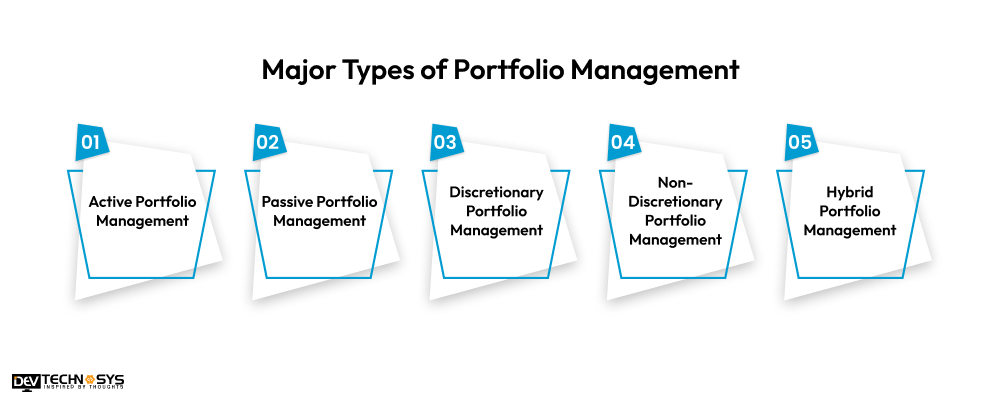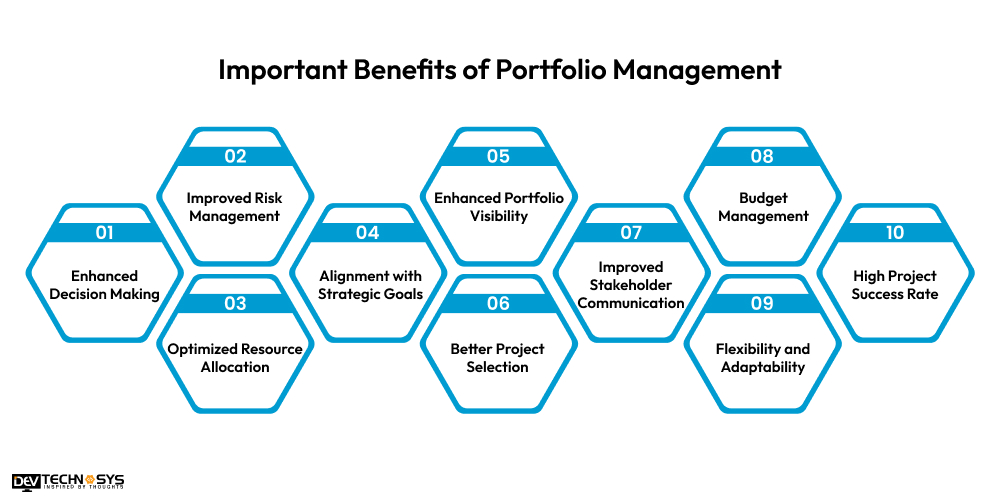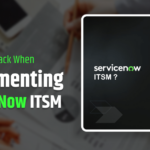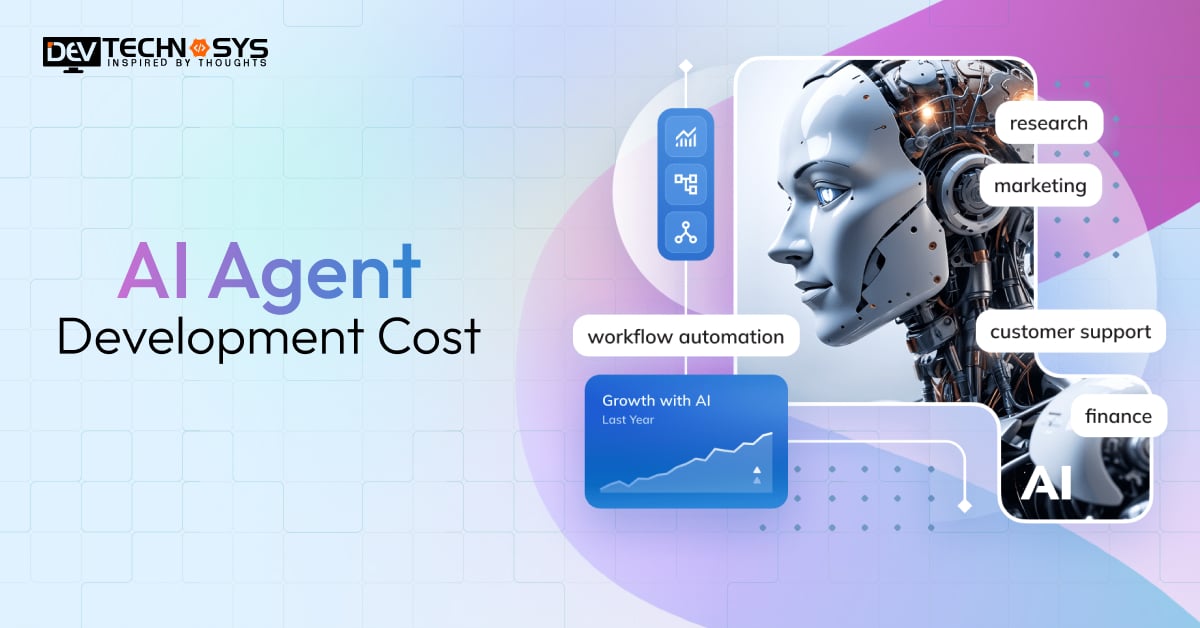Your clients and users should have the idea of the services they get from your side by investing in the business. So, the need to implement portfolio management services rises that allow industry professionals to collect all the facilities and work at one place. It is one of the most popular benefits of portfolio management.
This encourages business investors to showcase their work and attract more customers for delivery of services. Additionally, the development of management portals provide multiple benefits through which businesses can evaluate errors and correct them timely.
Here, we are looking at different types of portfolio management at first. Then, we will move on to different benefits of portfolio management.
Major Types of Portfolio Management
To strategically allocate resources and achieve financial goals strategic portfolio management is essential for organizations. Different types of portfolio management strategies are used based on risk tolerance, investment objectives, and market conditions.

1. Active Portfolio Management
Active portfolio management involves frequent buying and selling of assets to outperform market benchmarks. By using ServiceNow managed services fund managers can continuously analyze market trends and individual securities, aiming to capitalize on short-term market fluctuations.
2. Passive Portfolio Management
Passive portfolio management focuses on long-term growth by mimicking the performance of a specific market index or benchmark, such as the S&P 500. It involves fewer trades, as the goal is to match the market’s returns rather than beat them.
3. Discretionary Portfolio Management
Discretionary portfolio management gives fund managers the authority to make investment decisions on behalf of clients based on their goals and risk profiles. By knowing how to use ServiceNow for IT Service Management you can adjust the portfolio, buy or sell assets, and manage investments according to changing market conditions.
4. Non-Discretionary Portfolio Management
Non-discretionary portfolio management involves a more collaborative approach where the portfolio manager provides advice, but the client retains the final decision-making authority. The manager may suggest buy, hold, or sell actions, but the client is ultimately responsible for executing trades.
5. Hybrid Portfolio Management
Hybrid portfolio management combines both active and passive strategies to create a balanced investment approach. The portfolio manager may actively manage certain asset classes while using passive strategies for others. This is one of the major benefits of ServiceNow Managed Services that seeks to optimize risk-adjusted returns by diversifying strategies based on market conditions.
10 Important Benefits of Portfolio Management
Portfolio management is a crucial aspect of strategic financial planning, helping businesses and individuals optimize their investments. It enables better decision-making, enhances returns, and minimizes risks.

1. Enhanced Decision Making
Portfolio management provides a comprehensive view of all projects, investments, or assets in one place, enabling better decision-making. With detailed data analysis, managers can create a dashboard in ServiceNow with more informed choices regarding project portfolio optimization and resource allocation.
It reduces uncertainty by offering insights into how decisions affect the overall portfolio. This leads to smarter, more effective actions that align with business goals. Having access to real-time information also ensures decisions are based on current market conditions and trends.
2. Improved Risk Management
Enterprise investment portfolio helps identify and assess potential risks by evaluating the performance and interdependencies of all projects. By diversifying investments and managing exposure across different sectors or assets, risks can be minimized.
A structured portfolio approach allows for early detection of problems, enabling proactive ServiceNow migration services. It also ensures that the company isn’t overly reliant on a single project or investment, spreading risk effectively. Regular monitoring ensures risks are managed throughout the life of the portfolio.
3. Optimized Resource Allocation
Effective portfolio management ensures that resources whether financial, human, or technological are allocated to the most valuable projects. By aligning HR Service Delivery resources with high-priority initiatives, you can maximize the return on investment. Business portfolio alignment tools help assess resource needs across all projects, ensuring that the right resources are available when needed.
This strategic allocation reduces wastage and ensures that the most important projects are adequately funded. Efficient resource distribution also helps in achieving overall portfolio objectives within set timelines and budgets.
4. Alignment with Strategic Goals
A well-managed portfolio ensures that every project portfolio optimization or investment aligns with the organization’s long-term strategic goals. By evaluating how each component contributes to the broader vision, companies can prioritize initiatives that drive growth, innovation, and competitive advantage.
This alignment ensures that all projects are working toward the same objectives, which is IT Service Management and maximizing the likelihood of success. Regular portfolio reviews allow businesses to adapt to changing strategic priorities and market conditions. Ultimately, it ensures that resources are invested in areas that offer the highest value.
5. Enhanced Portfolio Visibility
Portfolio management for enterprises provides real-time insights into the status, performance, and risks associated with every project or investment. Hiring of a ServiceNow development company allows stakeholders to track progress, identify potential issues, and make adjustments before problems escalate.
With clear reporting, organizations can see how each project is performing against expectations, improving transparency. Portfolio visibility also fosters better communication between teams, leading to quicker issue resolution. It also helps senior leadership stay informed and make more strategic decisions based on the full picture.
6. Better Project Selection
Strategic Portfolio management ensures that only the most promising and strategically aligned projects are selected for investment. By assessing right ServiceNow consulting services based on risk, return, and alignment with business objectives, organizations can make smarter decisions.
A clear framework helps in evaluating each project’s value proposition and its potential impact on the overall portfolio. This leads to better use of capital and resources, as projects are chosen based on their potential to drive growth and achieve goals. It also reduces the chances of pursuing projects that don’t deliver desired results.
7. Improved Stakeholder Communication
Business portfolio alignment helps to understand what is a ServiceNow implementation improves communication by providing stakeholders with consistent updates and clear visibility. Regular reports and dashboards ensure that everyone from team members to executives has access to the same information.
This transparency fosters trust and helps stakeholders make informed decisions about resource allocation and priority setting. By maintaining open lines of communication, the organization can address concerns early and adjust the strategy when necessary. This also ensures alignment among all parties involved in the decision-making process.
8. Budget Management
Portfolio performance tracking helps organizations monitor and control costs by tracking the financial performance of each project. It ensures that spending stays within budget and aligns with the overall financial strategy. By evaluating costs against expected returns, managers can identify areas where savings can be made or investments need to be reallocated.
Businesses can hire ServiceNow developers for managing regular budgets, make timely adjustments and avoid overspending. This helps in maintaining profitability and ensuring that financial resources are used efficiently across the entire portfolio.
9. Flexibility and Adaptability
Portfolio management for enterprises enables organizations to remain agile in a dynamic market by providing the flexibility to shift resources and strategies quickly. It helps businesses to know what is ServiceNow and respond to changing market conditions, new opportunities, or emerging risks. By continuously assessing the performance of projects and investments, adjustments can be made to better align with evolving goals.
This adaptability ensures that businesses can pivot when necessary without losing focus on long-term objectives. The ability to reallocate resources across projects also supports business continuity during unforeseen challenges.
10. High Project Success Rate
With portfolio performance tracking, businesses can improve their project success rate by systematically selecting, managing, and monitoring projects. It helps identify high-priority, high-impact projects and allocate resources accordingly. Continuous oversight ensures that projects remain on track, meeting deadlines, budgets, and quality expectations.
By using ServiceNow support services and aligning projects with strategic goals, portfolio management enhances the chances of success. Regular assessments also provide the opportunity for timely intervention, preventing project failures before they occur.
Concluding the Blog!!
Among different ServiceNow elements, the use of ServiceNow implementation services could help in the development of various portfolios and business profiles. From the above benefits of portfolio management, businesses can easily target their industry-specific goals. Additionally, they are able to streamline their services through dashboard access.
It is very easy to implement risk management in portfolio if you are developing management portals. So, it is the right time for business investors to start with the development of an enterprise investment portfolio to keep the industrial competition alive.
FAQs
1. What is portfolio management for large enterprises?
Portfolio management for large enterprises involves strategically managing a collection of investments, projects, or business units to achieve long-term objectives. It helps align resources with business goals while minimizing risks. The aim is to maximize value while maintaining efficiency across diverse operations.
2. How does portfolio management help with risk management?
Portfolio management helps mitigate risk by diversifying investments and projects across different sectors. It ensures that the enterprise isn’t overly reliant on one area, reducing exposure to market volatility. Regular assessments allow companies to adapt to shifting market conditions.
- Reduces concentration risk.
- Helps to identify potential risks early.
- Diversifies investments across various sectors.
3. Why is portfolio management important for aligning business goals?
Portfolio management ensures that all projects and investments are aligned with the company’s strategic objectives. It helps prioritize initiatives that provide the highest value. Resources are allocated efficiently, ensuring that growth opportunities are maximized.
- Aligns investments with company vision.
- Prioritizes high-value opportunities.
- Ensures efficient use of resources.
4. How can portfolio management improve decision-making?
By providing a comprehensive view of all ongoing initiatives, portfolio management allows decision-makers to make informed choices based on data and analysis. It supports better prioritization and allocation of resources. This leads to more effective and efficient strategies for growth.
- Provides comprehensive data for decision-making.
- Improves resource allocation.
- Enhances strategic alignment.
5. How does portfolio management increase efficiency within large enterprises?
Portfolio management streamlines operations by organizing projects and investments under a unified strategy. This reduces redundancies and prevents resource conflicts. It optimizes the workflow and ensures that teams are focused on high-priority tasks.
- Reduces duplication of efforts.
- Improves coordination across departments.
- Streamlines decision-making processes.
6. Can portfolio management drive innovation in large enterprises?
Effective portfolio management encourages innovation by balancing riskier, high-reward projects with more stable, low-risk investments. It ensures that companies invest in emerging opportunities while maintaining a steady foundation. This approach fosters a culture of innovation and adaptation.
- Encourages strategic risk-taking for innovation.
- Supports long-term sustainability while fostering growth.
- Ensures balanced investment in both new and stable ventures.



























